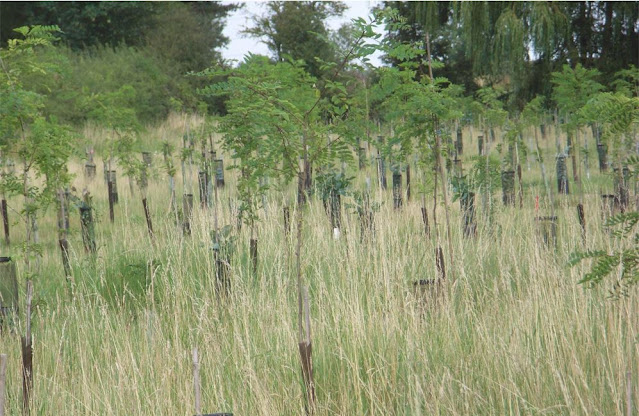Felling.
One of the troubles with growing Eucalypts is that they can grow very fast.
 |
| Two six year old E. vinimalis blown over winter 2021/2. They have a basal diameter of around 6 inches. |
When they are grown amongst other trees they can have root systems not capable of supporting their canopies. They try to get above the other trees and have a high canopy exposed to the wind unprotected by the other trees. If the ground is very wet then the soil has little strength and the trees can be blown over. The situation in the triangular compartment is exacerbated by the high winter water table, which restricts root growth.
Early 2020 saw storms Brendan, Ciara and Dennis saturate the ground and several of the original Eucalyptus were blown down. The root plate holes were full of water. I had started felling the largest trees for fire wood, but had selected the trees I thought were easiest to fell. At Pit Wood the Eucalypts are in amongst the other trees, and can be very much larger. They risk damaging other trees if they are blown over, or if they are felled. A decision was made to fell larger trees, at least there is the possibility of felling in a direction to minimise collateral damage.
In the triangular field the largest Eucalypts are from the original planting, so are in recognisable rows and are large enough to need felling. The Eucalypts have strong apical dominance and tend to grow straight up. This means it may be possible to fell in a direction where they will do least damage. When planted in rows it may be possible to fell them all down one side or the other of the row. The picture on the left is of one felled down the middle of the row and balancing on the previously cut stump!
Because of their apical dominance should they fork then the two limbs grow nearly parallel as in the felled trunk below
The photos above show a forked trunk that has been felled. It can be seen that there is no live wood joining the parts. There is a tendency for one to break in the wind, and then the other. This happened to the post towards the end of the row in the balancing picture above.
A problem with the different growth rates can be seen in the photo below.
Two Eucalypt pollard stumps can be seen in the front centre of the Photo. They will have been as tall as the as the two Eucalypts with silver trunks and the ones with brown trunks on the far Left at the back. There is a Norway Spruce on the right and a pine stump. These were part of the planting that was mainly felled for the Eucs and conifers to be planted. The Conifers mainly Coast Redwoods are 6-10 foot high while the Eucs were 30-40 ft. The Eucs have been pollarded while they are still relatively manageable and can be felled with little damage to the conifers. They have done their job of providing shelter they now compete with the potential timber trees and will become fuel logs.









